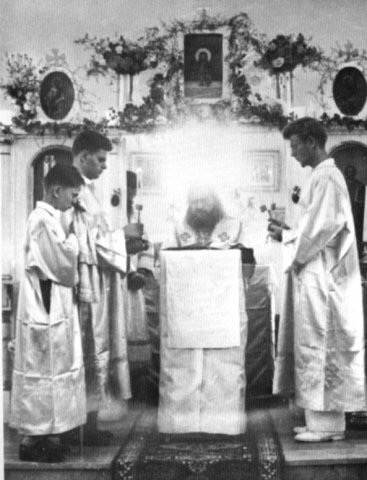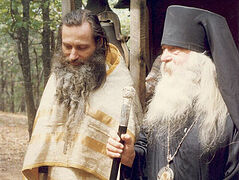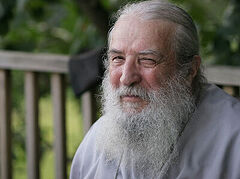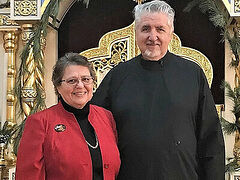 Elder Nektary’s grave before the transfer of his relics
Elder Nektary’s grave before the transfer of his relics
On the night of May 12, 1928, Elder Nektary reposed in the arms of Fr. Adrian Rymarenko, who had barely reached Kholmischi the day before, through the spring thaw, as if to see his spiritual father off on his final journey and read the departing prayers for him.
According to the Elder’s will, he was buried a mile or two from the village of Kholmischi, in the village cemetery. His relics were uncovered in 1992. The brethren of the revived Optina Monastery first discovered the grave of Bishop Nektary’s mother, Schema-Nun Nektaria, and then, a little off to the side, the coffin with the Elder’s relics.
The amber-colored relics were solemnly transferred to the Entrance Cathedral at Optina. The Optina brothers recalled:
“When the solemn procession moved through the monastery, which met its Elder with honor after sixty-five years of separation from him, a wondrous fragrance emanated from the relics, which was felt at a distance of up to 100 feet or more.”
“Rules for Pious Living”
Shortly before his repose, Elder Nektary blessed Oleg to take spiritual guidance from his other spiritual son—Fr. Adrian Rymarenko (1893-1978)—in whose arms the Elder departed to the Lord.
Later, Fr. Adrian would recall how on his name’s day, in 1925, Elder Nektary gave him the pamphlet, “Rules for Pious Living,” compiled by Archbishop Platon (Fiveisky) of Kostroma and Galich (1809-1877), stating: “This is your name’s day gift.”
For Fr. Adrian, these “Rules for Pious Living” were like the testament of Elder Nektary, and he spiritually instructed Oleg in accordance with them. Here are a few pieces of advice from these “Rules”:
If you want a peaceful life, give all of yourself up to God.
Don’t do anything against the Commandments of God; don’t covet or seek anything other than God; do and endure everything for God.
Don’t worry about being respected and loved by people of this age, but about pleasing the Lord God, and making sure your conscience doesn’t convict you of any sins.
If you want to ceaselessly remember God, then bear sorrows and misfortunes as having justly befallen you.
Learn to see something good in everything you see. Be meek, quiet, humble; be silent and patient, following the example of Jesus. He won’t lay a cross upon you that you can’t carry; He Himself will help you carry the cross.
Don’t think of acquiring any virtue without sorrow and sicknesses of the soul.
If you’ve fulfilled some commandment of God, expect temptation, for love for Christ is tested through overcoming obstacles.
Don’t remain idle even for a short time, but always be in labors and studies.
 Archbishop Andrei of Rockland
Archbishop Andrei of Rockland
A providential tonsure date
In 1949, Archpriest Adrian Rymarenko (the future Archbishop Andrei of Rockland) moved to the U.S. with an assignment from the ROCOR Synod to organize the Novo-Diveyevo Dormition Convent. In the monastery’s heyday, about fifty Russian nuns lived there, who carefully preserved the precious sacred items: an icon of St. Seraphim of Sarov painted during his lifetime; a cross and two icons of the Savior from the Ipatiev House in Ekaterinburg, which were with the Royal Family until the very end; and the Vladimir Icon of the Mother of God from Optina—a gift of the last elders to Kiev.
Oleg followed after his spiritual father. By the prayers of Elder Nektary of Optina, he dedicated his life to the service of the Church and became a monk, as the Elder had foretold him. He took monastic vows on October 11/24, 1953, with the name Nektary.
No one knew then that the Optina Elders would be glorified several decades later (St. Ambrose in 1988, and the rest in 2000), with the Synaxis of Optina Elders being celebrated precisely on October 11/24. Then it became clear that Oleg’s tonsure date wasn’t chosen by chance, but by the will of God and the blessing of the Optina Elders.
The next day after the tonsure, Monk Nektary was ordained as a hierodeacon, and a week later as a hieromonk. On September 17, 1959, he was elevated to the rank of igumen, and in 1962, he was consecrated as Bishop of Seattle, vicar of the Western American Diocese.
 Archpriest Stefan Pavlenko, Vladyka Laurus (Škurla), Vladyka Anthony (Medvedev), Vladyka Nektary, Archpriest Peter Perekrestov; back row: the future Archpriest Sergei and Matushka Maria Kotar
Archpriest Stefan Pavlenko, Vladyka Laurus (Škurla), Vladyka Anthony (Medvedev), Vladyka Nektary, Archpriest Peter Perekrestov; back row: the future Archpriest Sergei and Matushka Maria Kotar
Vladyka put his huge hands on our little heads
Vladyka Nektary was such a large man—tall, bulky, strong—like a bear, in a good sense, of course. He would put his huge hands on our little heads, and we’d get lost in the sleeves of his riassa. We couldn’t see anything out from under these sleeves, but it was fun that Vladyka was playing with us. He really loved children. He would imitate the singing of various birds—he knew how to talk and play with children.
He spoke quietly, slowly, with such a calm voice. In this respect he was the complete opposite of our other bishop—Archbishop Anthony (Medvedev) of San Francisco and Western America. He was, on the contrary, very quick, agile, and energetic.
Vladyka would often sigh when he was telling us something. He loved to remember Optina, Russia—he always had such spiritual conversations. This spirit was conveyed to us—the true Orthodox spirit.
Preserve the grace of Communion
Vladyka once told us about how he and his mother went to see Elder Nektary of Optina, and Vladyka, still young Oleg then, communed. After the Sacrament, the Elder blessed him:
“After communing of the Holy Mysteries of Christ, go to the forest and be there alone: Try to preserve the grace of Communion in purity, without any fuss.”
I have remembered this short story my entire life. After all, we take Communion, and then we immediately fall into the hustle and bustle, and we have to learn to value this grace given us in Communion.
We can’t physically go out and live in the forest, but we can try to live this day without unnecessary fuss, keeping ourselves in silence. If we have to say something about work or some other matter, we have to at least try to avoid idle talk…
This is the advice of the Optina Elder that our Vladyka Nektary gave us, and I still remember it many years later.
Those who stood at the source of Bishop Nektary’s Church ministry
Vladyka Nektary especially revered the holy New Martyrs and Confessors of Russia. He had known some of them personally.
First was, of course, his beloved Elder Nektary, persecuted and tortured by the godless authorities.
This also includes His Holiness Patriarch Tikhon (1865-1925), whom the young Oleg served with as an altar boy, and who was glorified by the Russian Church Abroad in 1981 as a confessor, and by the Russian Church as a holy hierarch in 1989.
There’s also Hieromartyr Onuphry (Gagalyuk, 1889-1938), Archbishop of Kursk and Oboyansk. He had a wonderful fate, many sorrows, and miraculous cases of God’s providence for his life and salvation. His father, a forester, caught some other foresters at the scene of a certain crime. They beat him so badly that he died from his wounds in the hospital, then they burned down his house, leaving his widow and six children without a breadwinner or a roof over their heads.
The mother of the future bishop, Ekaterina, recalled later:
My son, Anton, five years old, climbed up on my lap and hugged me around the neck, saying: “Mama! Don’t cry—when I’m a bishop, you’ll come be with me!” I was so amazed by what he said, because I didn’t understand its meaning, and I was even so frightened that I asked him: “What did you say? What bishop? Where’d you hear this word?” But he only repeated it confidently and seriously: “Mama, I’m going to be a bishop. I know it.”
Ekaterina put her children in an orphanage and got a job there herself as the cook. The future bishop studied so well that he went to seminary with money from the orphanage. He graduated from seminary with honors, and in 1915, from the Theological Academy in St. Petersburg.
While studying at seminary, he got pneumonia and was near death when St. Onuphry the Great (an early Christian saint of the fourth-century Egyptian desert) appeared and healed him. He got sick again and was near death again while studying in the Academy, and St. Onuphry appeared to him a second time and again healed him. Obviously it’s no surprise that the young man was tonsured into monasticism with the name of St. Onuphry the Great, who himself decided to become the spiritual patron of the future hieromartyr.
Archbishop Onuphry was arrested several times and was accused of preaching too often, of criticizing Darwin’s theory, and of providing material assistance to clergy who were released from prison, and of blessing monastic tonsures to take place.
In 1935, he was sentenced to ten years in prison, and in 1938, while serving his sentence, he was sentenced to death and shot. He was rehabilitated in 1990. Hieromartyr Onuphry (Gagalyuk) spent time at the Konzevitch house, and Oleg knew him well.
In 1935, Oleg was tonsured as a reader by Bishop Joseph (Chernov) of Taganrog (1893-1975). Bishop Joseph, the future Metropolitan of Alma-Ata and Kazakhstan, a man of prayer and ascetic of piety, was also arrested by the NKVD in 1935 and spent five years in camps.
During World War II, when Taganrog was occupied by the Germans, Vladyka Joseph resumed his public ministry as the Bishop of Taganrog. He later refused to take part in Nazi propaganda events and so was arrested, this time by the Gestapo. He was in a German prison from November 6, 1943 to January 12, 1944.
After the city was liberated by units of the Red Army, he was arrested by the NVKD again, and spent 1944 to 1956 first in Butyrka Prison, then two special-purpose camps and exile, where the sixty-three-year-old Vladyka was forced to work as a water carrier.
These are the fates of people who stood at the source of the Church ministry of the future Bishop Nektary.
Vladyka firmly believed that the Lord would have mercy upon the Russian land by the prayers of the New Martyrs and Confessors of Russia
Archpriest Andrei Papkov (of the Holy Dormition Cathedral in Chicago) testifies:
Vladyka Nektary told me: “Imagine that when we prayerfully call out: ‘Holy New Martyrs and Confessors of Russia, pray to God for us,’ they all turn to the throne of God and exclaim: ‘Lord, have mercy!’—and the Lord, by their prayers, will have mercy on the Russian land.
Vladyka firmly believed this. I remember with what tears of tender emotion and fervent prayer Vladyka participated in the powerful magnification of the New Martyrs that rang out for the first time on the celebration of their glorification in 1981. It may seem strange that this was noticeable among such a confluence of clergy and worshipers. But this was exactly the case, because out of all our hierarchs, Vladyka was the only personal witness to the events of the 1920s-30s, when so many new passion-bearers shone forth.
It’s appropriate to mention here that Vladyka himself was secretly tonsured as a reader in 1935 by Bishop Joseph (Chernov) in Taganrog, and thereby joined the ranks of the clergy of the persecuted Church.
 A photo of Vladyka Joseph from the investigative case
A photo of Vladyka Joseph from the investigative case
My “grandpa” Vladyka Nektary and my spiritual father Seraphim (Rose)
As I have already said, when I was a child, my family was spiritually nurtured by Vladyka John of Shanghai, and then Vladyka himself brought his spiritual son, Eugene Rose, a reader of the Joy of All Who Sorrow Cathedral, the future Hieromonk Seraphim (Rose), to our family. When I grew up, St. John had already departed to the Lord, and Fr. Seraphim became my spiritual father. I often went to see him in the hermitage—to the St. Herman’s Skete, which later became a monastery.
After the blessed repose of the wonderworker St. John, Fr. Seraphim himself was spiritually pastored by Vladyka Nektary (whom I considered my grandpa in my childhood).
Bishop Nektary often reminded Fr. Seraphim: “Above all, preserve everything that Vladyka John blessed. This is our direct responsibility.”
“Vladyka Nektary was always a source of inspiration and consolation for us”
It was “my grandfather,” Bishop Nektary, who ordained Monk Seraphim (Rose) to the priesthood. A disciple of Fr. Seraphim, and also his biographer, Hieromonk Damascene (Christensen), recalled this ordination as follows:
[Bishop Nektary] was concentrating intensely. His face was red; sweat was pouring down his forehead… “I wish,” whispered the righteous hierarch. “I wish only one thing. If only I could transmit, transmit—and then die!” Bishop Nektary was using all the power and life that God had breathed into him, in order to transmit the apostolic grace of the Holy Spirit, and the holiness of Optina.
Fr. Seraphim always felt the prayerful support of Vladyka Nektary. Vladyka lived in San Francisco and would go to Seattle for the feasts, and although he had a bad heart and it was already difficult for him to travel, he always visited St. Herman’s Skete on the way there and back.
In one of his letters from 1972, Fr. Seraphim wrote:
Vladyka Nektary visited us on his way to Seattle—he was quite weak, but still he was able to undertake such a tiring trip. He is always a source of inspiration and consolation for us.
In another letter, Fr. Seraphim remarked:
First of all, of course, our teachers should be the pillars of the older generation: Vladyka John of Shanghai and Avery (Taushev), and others like them. Vladyka Nektary is the most valuable representative of this generation of those who are still alive. May the Lord grant him many years of life!
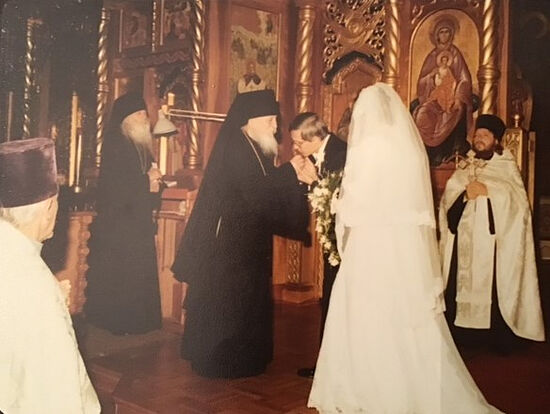 The wedding of Serge and Maria Kotar. Vladykas Anthony and Nektary
The wedding of Serge and Maria Kotar. Vladykas Anthony and Nektary
The blessed repose of Vladyka Nektary
When my spiritual father Seraphim (Rose) departed to the Lord (September 2, 1982), Vladyka Nektary came to the monastery on the fortieth day. He served the Liturgy and then gave a homily in which he called Fr. Seraphim a holy righteous one.
Bishop Nektary himself outlived Fr. Seraphim only by a little bit—he departed to the Lord half a year later. On the eve of the Synaxis of the New Martyrs and Confessors of Russia, the already greatly weakened Vladyka gathered his last strength and prayed at the All-Night Vigil in his beloved Joy of All Who Sorrow Cathedral, built by St. John of San Francisco.
The next morning, February 6, 1983, at the end of the early Liturgy, the news spread that Vladyka Nektary had departed to the Lord. In his cell, on the table lay the service to the holy New Martyrs and Confessors of Russia, whom he so revered.




